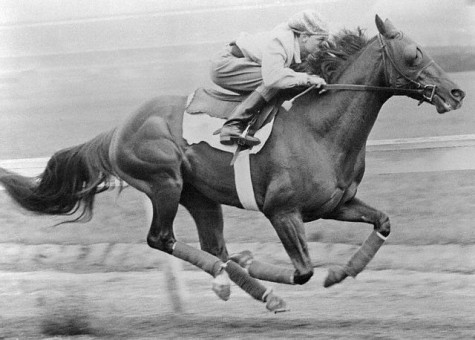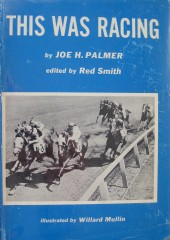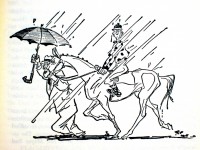
Reviewed:
This Was Racing by Joe H. Palmer
272 pp., 1953, Currently out of print
Throughout its history from 1924 to 1966, the New York Herald Tribune featured a high-class stable of writers: Walter Lippmann, Joseph Mitchell, John Ashbery, Red Smith, William Safire, Lewis Lapham, and briefly, near the end of the paper’s run, Jimmy Breslin and Tom Wolfe. The newspaper business doesn’t lend itself to lasting memories, and most of those names are familiar for the work they did after leaving the Herald Tribune. Another of the paper’s great talents, Joe H. Palmer, died while employed there and is now largely unknown even among those who share the passion for his subject.
The greatest handicap to Palmer’s standing in posterity was his area of expertise, horse racing, its widespread popularity in the 1940s now only approached on the days of Triple Crown races, if then. But if the nature of a beat should never limit the legacy of a writer’s prose, the slight is particularly unjust in the case of Palmer, who reached an audience far beyond the paddocks. In his introduction to This Was Racing, a collection of Palmer’s columns, Red Smith writes:
“ ‘Did you read Palmer today?’ was a question heard weekly, not only among admiring professionals who write for a living, not only among the racing crowd where he was loved and respected, but also among many whose interest lay in neither field but rather in the pure pleasure of reading.”
 After Palmer’s untimely death in 1952, at the age of 48, Smith began receiving letters from readers. “I have never been to a race track,” ran a typical note, “I have no interest in racing and I never met Mr. Palmer, yet I feel I have lost a friend.”
After Palmer’s untimely death in 1952, at the age of 48, Smith began receiving letters from readers. “I have never been to a race track,” ran a typical note, “I have no interest in racing and I never met Mr. Palmer, yet I feel I have lost a friend.”
It doesn’t take more than a few minutes with This Was Racing to understand their mourning. Palmer is good company, brimming with both playfulness and deep feeling. In a piece about Man o’ War’s owner, Samuel Riddle, he showcased the best of his winning style, a marriage of Runyonesque wit and a more classical rhythm:
Well, this fiery thing of blood and bone (a bow to Mr. Masefield here) was Mr. Riddle’s own. It could very easily have gone to his head. I tell you this as one who has seen people make fools of themselves over far lesser horses. Mr. Riddle was much prouder of Man o’ War than you are of your children, and probably with more reason, and possession of him was a stately music. [. . .]
Any number of people had bright ideas about Man o’ War, nearly always to their personal enrichment. The movies wanted him. There was a very remunerative scheme to tour him around the country for exhibition. At all such propositions Mr. Riddle snorted. The verb here has been very carefully chosen, and when Mr. Riddle snorted at a proposition, then that proposition lay dead and partly decomposed.
The Masefield mentioned above is John Masefield, Poet Laureate of the United Kingdom from 1930 to 1967. Such allusions in Palmer’s work were frequent and effortless. He had been a professor of English at Kentucky and Michigan, and had finished all the work for a doctorate but his thesis when the opportunity to write about racing came along. In his columns, he was wont to include a reflection “obtained second-hand from Thoreau” or “to steal slightly from Mr. Kipling.” He cited specific lines from Robert Browning and Emily Dickinson to illustrate a belief in the edifying role of life’s tribulations, such as “a 4-to-5 chance going to the outside fence.” He compared jockey Eddie Arcaro at length to the 16th-century Italian autobiographer Benvenuto Cellini. In one column, he remembered Man o’ War’s groom speaking to a British ambassador, “unrolling the long glories of Man o’ War and his sons and daughters . . . like Tennyson on the passing of Arthur.”
The sport was popular enough in Palmer’s lifetime that he could confidently (and famously) claim that “racing is an athletic contest among horses” and that the betting aspect “isn’t what people go to see, and it isn’t what you pick up a paper to read about.” Surely, many if not most of his readers were bettors, but aside from an occasional quip about odds, he was genuinely more interested in the social side of the track than in gambling. He compared racing to bridge and canasta, excuses for people to get together as much as pursuits for their own sake.
This outlook meant that Palmer ignored the many books sent to him about how to cash more tickets: “[P]eople everywhere seem to enjoy bewildering themselves methodically,” he wrote. “I think this was originally said about theology, but it will do for horseplaying by system.”
I don’t want to give the impression that an interest in the sport, or a knowledge of its history, is entirely unnecessary to an enjoyment of This Was Racing. But it’s easy enough to skim any confounding details and focus on the more universal sentiments. Like many great writers and conversationalists, Palmer mostly circled his ostensible subject, rarely landing on it. The most memorable stretches of the book aren’t about racing at all. They’re about recipes for jellied whiskey or the Australian hobby of “kangaroo chasing” or listening to a band torture “My Old Kentucky Home.” (”I could have played it better on a comb.”)
Or they’re about Palmer simply lounging in the corners of the sport. “A man who spends his life poking around race tracks gets,” he wrote, “in addition to a view of human nature which is at once more tolerant and less rosy than any warmly endorsed by the clergy, a rather unreasonable fondness for certain places.” “Places” is one of the five headings under which the collection is organized, and Palmer always showed top form ruminating on the pastime’s prominent locales. He was an easy crowd, prone to expressing affection for even the less pastoral tracks. Though he wrote, “You may love Pimlico to your heart’s content but you cannot, on oath, call it pretty,” he started another column: “Pimlico was lovely and satisfying, as usual. Or perhaps it is just that a man full of Maryland fried chicken can think only soft thoughts.”
Like many racing fans, though, Palmer saved his warmest thoughts for Saratoga, which opened its doors in 1863:
Perhaps nothing is as hard to do, or as expensive, as to keep time from passing, and Saratoga has mastered at least the illusion of this. . . . Saratoga has its critics, of course, but it is customarily shelled from long range. Let a man hang around the place for a while and drink his breakfast from the clubhouse porch and you have no more trouble with him.
His assignments sometimes took him to Baltimore, Saratoga, South Carolina, Florida, and Kentucky, but Palmer’s work is entirely possessed of a mid-century New York flavor. The track is a notorious breeding ground for outsize characters and tall tales. Like Joseph Mitchell, Palmer profiled the characters and passed along the tales with relish, and as with Mitchell’s stories, it’s exceedingly difficult for a grateful reader to care if they’re true. The bouncy, opinionated, unmistakable patter of everyone from Damon Runyon to Holden Caulfield was Palmer’s stock in trade. You read him to hear a cadence that has gone extinct.
 This Was Racing is old-fashioned in other ways both charming and less so—the illustrations by Willard Mullin throughout are charming; the antiquated attitude about Seminoles at a race track in Florida less so. But what is simultaneously redolent of its time and timeless is Palmer’s wisdom-of-a-wise-guy tone, as in this passage about John Blanks Campbell:
This Was Racing is old-fashioned in other ways both charming and less so—the illustrations by Willard Mullin throughout are charming; the antiquated attitude about Seminoles at a race track in Florida less so. But what is simultaneously redolent of its time and timeless is Palmer’s wisdom-of-a-wise-guy tone, as in this passage about John Blanks Campbell:
There is a sure way for a man to make approximately $5,000. It is to go into Mr. Campbell’s office with a tape recorder and to encourage him to tell tales of City Park and Tiajuana and Agua Caliente and Douglas Park and of other race tracks which flourished before racing decided it would settle down. The book would make $200,000, and the libel suits resulting from it should not detract more than $195,000 from this.
Palmer wasn’t an apologist for racing’s darker side: “The contention isn’t that everything is all right in racing. If there is any considerable industry involving millions of dollars and thousands of men in which everything is all right, it ought to be stuffed and put on exhibition.” But he was clearly a sentimentalist who chose to focus on the aspects of the game that raised his spirit, and that might raise ours.
John Williams is the editor of The Second Pass.
Mentioned in this review:

